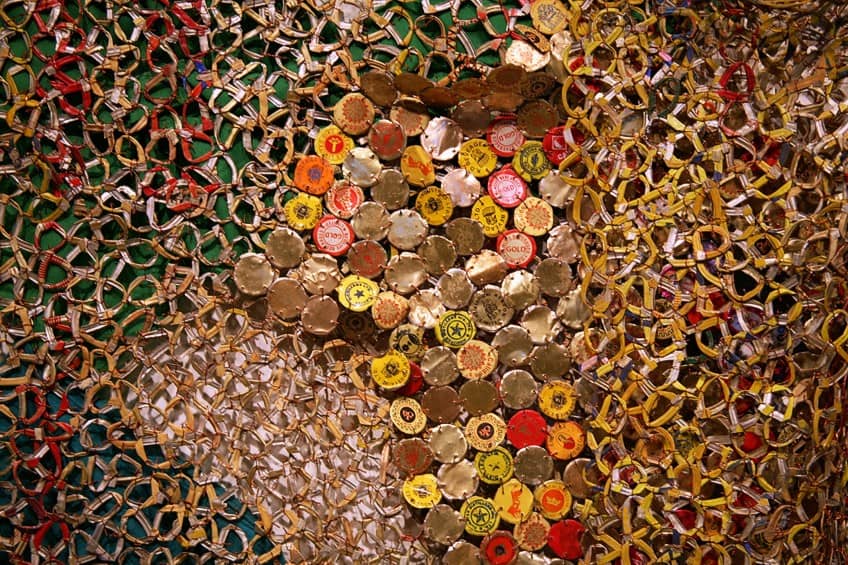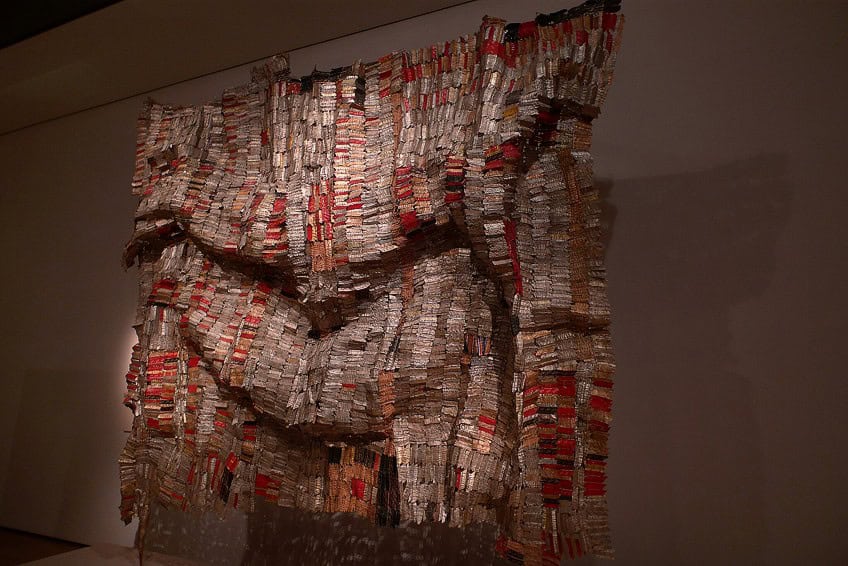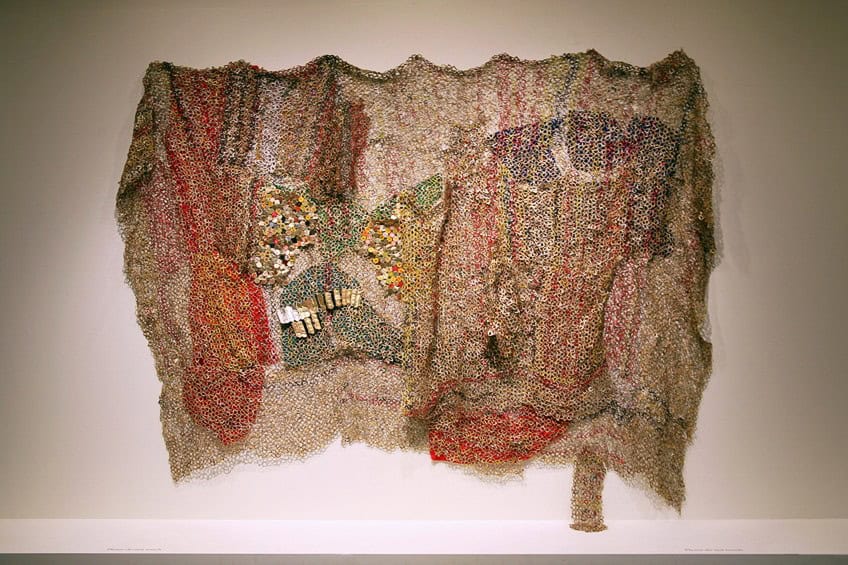El Anatsui – The Life of the Famous Ghanaian Sculptor
El Anatsui, a Ghanaian sculptor and artist, is celebrated for his transformative use of recycled materials to create intricate and monumental installations that explore themes of history, culture, and identity. Born in 1944 in Anyako, Ghana, Anatsui has spent much of his career in Nigeria, where he has profoundly influenced contemporary African art. His signature works, often composed of discarded bottle caps, aluminum, and copper wire, are notable for their fluid, tapestry-like forms that challenge traditional notions of sculpture. These works not only reflect his innovative approach to materials but also address broader social and environmental issues, making El Anatsui a pivotal figure in the global art scene.
Key Takeaways
- El Anatsui is renowned for his recycled “bottle-top installations.”
- His work addresses themes of colonialism, migration, and resilience.
- Anatsui’s art has been showcased at major international venues.
Early Life and Education
| Birth | February 4, 1944 |
|---|---|
| Death | Present |
| Place of Birth | Anyako, Volta Region, Ghana |
| Genre of Work | Sculpture and installation art |
El Anatsui, born on February 4, 1944, in Anyako, Ghana, is a sculptor who has made significant waves in the art aworld. Best known for his transformative “bottle-top installations” crafted from recycled materials, his work uniquely combines traditional African influences with contemporary techniques. These installations, comprising thousands of aluminum pieces joined with copper wire, represent both a creative recycling process and a profound commentary on history and society.
Anatsui’s artistic journey has been characterized by experimentation with various local materials, reflecting a deep connection to his African heritage.
He has spent a large part of his career in Nigeria and has gained international acclaim for his ability to weave narratives of colonialism, migration, and resilience through his large-scale metal tapestries. This blend of tactile beauty and complex themes positions Anatsui as a pivotal figure in modern sculpture.

Exploring his exhibitions at prominent venues like Tate Modern and upcoming projects highlights the global impact of Anatsui’s work. His art not only stands out for its visual grandeur but also for its ability to provoke thought and dialogue about critical social issues—making El Anatsui’s contributions to the art world both visually and intellectually enriching.
Birth and Background
El Anatsui was born on February 4, 1944, in Anyako, a small fishing village in the Volta Region of Ghana. He was the youngest of his father’s 32 children, and after losing his mother at a young age, he was raised by his uncle. Growing up in a mission house instilled in him a sense of discipline and a need to focus on what was necessary without indulging in extravagance.
The cultural heritage of the Ewe people and the environment of Anyako significantly influenced his early perceptions of art and materials.
Academic Pursuits
El Anatsui’s academic journey began in local schools where his talent for art was first noticed. His primary interest in drawing letters on a chalkboard caught the attention of his school’s headmaster, who encouraged him by providing additional materials.

He continued his education at the University of Science and Technology in Kumasi, Ghana, where he earned a degree in sculpture in 1969. His formal education not only honed his skills but also exposed him to various art traditions and materials, which later became crucial in his experimentation with different forms of handicraft and local materials.
Artistic Beginnings
Anatsui’s initial encounters with art were deeply rooted in his experiences and the local culture of Ghana. His work initially focused on traditional Ghanaian themes, but his style evolved significantly after moving to Nigeria. His early artistic endeavors included creating wooden sculptures before he famously transitioned to working with discarded bottle caps and other materials. These early experiments showcased his keen interest in transforming everyday materials into large-scale artworks.
His move to Nigeria marked a significant shift in his artistic practice, leading to the development of his signature style that blends art with environmental consciousness.
Artistic Style and Techniques
El Anatsui’s work showcases his inventive use of unconventional materials and transformative techniques. His pieces often address themes of history, culture, and the environment, utilizing materials like bottle caps, copper wire, and wood to create large, intricate artworks.
Material Innovation
El Anatsui is renowned for his use of found materials such as bottle caps, copper wire, and recycled metal. These materials are often sourced from alcohol recycling stations and transformed into expansive tapestries that mimic traditional woven fabrics like Kente cloth.

His sculptures, pieced together meticulously, feature small metal fragments sewn with copper wire, creating fluid, tapestry-like forms. This method is not just a recycling effort; it is a symbolic transformation, turning discarded objects into art that speaks about consumption, waste, and the environment.
Anatsui’s work also draws inspiration from traditional African textiles like Adinkra cloth, while incorporating visual languages such as Uli and Nsibidi.
Working primarily from Nigeria, Anatsui integrates local craft techniques, utilizing wood and other natural materials. His art resonates with themes of colonialism and the resilience of African culture, transforming simple materials into profound visual statements. The combination of cultural motifs and innovative techniques marks Anatsui as a pivotal figure in contemporary art.
Notable Works and Exhibitions
El Anatsui has made significant contributions to contemporary art, with his innovative use of materials and captivating visual language. His pieces have been displayed in prominent museums and galleries worldwide, distinguishing him as a prominent figure in international art circles.
Prestigious Exhibitions
El Anatsui’s works have been showcased in numerous major exhibitions around the globe. Venice Biennale featured his creations, highlighting his impact on modern art. In New York, his solo exhibition, Gravity and Grace, took place at the Brooklyn Museum, illustrating his transformative art. London’s October Gallery also exhibited his pieces, further establishing his presence in the European art scene.
Notably, his art has been a focal point at institutions like the Tate Modern and the Metropolitan Museum of Art.
Major Installations
El Anatsui’s installations are renowned for their large-scale and intricate construction. Dusasa I and Dusasa II represent some of his most celebrated works, utilizing aluminum pieces and copper wire. These installations transform everyday materials into monumental tapestries, making powerful statements about consumption and transformation.

Another significant work, Triumphant Scale, exemplifies his ability to manipulate metal into fluid, organic forms, challenging traditional definitions of sculpture. His installations at the Museum of Modern Art and Centre Pompidou have garnered critical acclaim and broad public interest.
Collections and Commissions
El Anatsui’s art is included in prestigious collections, ensuring a lasting legacy. Major museums, including the Metropolitan Museum of Art, and the Museum of Modern Art, feature his work. His pieces are also part of public collections in London and New York, reflecting his global influence.
High-profile commissions, such as those for the Venice Biennale and site-specific projects, showcase his ability to adapt his practice to various contexts, displaying his artistic versatility and depth.
Legacy and Impact
El Anatsui’s work as a Ghanaian sculptor has redefined contemporary African art. His innovative use of materials and decades of teaching at the University of Nigeria, Nsukka, have left a lasting impact on the global art scene.
Influence on Contemporary Art
El Anatsui’s sculptures, often fashioned from discarded materials like liquor bottle caps and printing plates, have expanded the boundaries of contemporary art. His method of transforming simple resources into complex visual narratives is celebrated for its innovative approach.

His work challenges traditional notions of sculpture by merging elements of African art with modern concepts. This blend has inspired numerous artists to explore new techniques and address themes such as environmental sustainability and cultural identity.
Awards and Acknowledgments
Throughout his career, Anatsui has received numerous accolades. Particular highlights include the prestigious Lifetime Achievement Award at the Venice Biennale in 2015. His contributions to art and education were further recognized by invitations to lecture and exhibit at top global institutions. His remarkable achievements are not confined to the art world; they have permeated academic spheres. As a long-time lecturer at the University of Nigeria, Nsukka, Anatsui has influenced countless students, fostering a new generation of African artists who continue to push artistic boundaries.
El Anatsui’s artistic journey is a testament to the power of innovation and cultural expression. Through his transformative use of discarded materials, he has redefined the boundaries of sculpture and installation art, creating works that resonate with profound historical and environmental narratives. His art transcends geographic and cultural barriers, inviting viewers to contemplate the interconnectedness of human experiences. As El Anatsui continues to inspire and influence the global art community, his legacy as a pioneering artist who elevates everyday materials to monumental significance remains firmly established.
Frequently Asked Questions
What Techniques Are Prevalent in El Anatsui’s Art Style?
El Anatsui is renowned for his use of found materials, particularly aluminum bottle tops. These bottle tops are meticulously sewn together with copper wire, forming large, intricate tapestries. His works often include wooden trays and mortars, highlighting a blend of traditional forms and modern re-purposing.
Where Can One Find El Anatsui’s Artworks for Sale?
El Anatsui’s artworks are often featured in major international exhibitions and museums. Interested buyers might explore reputable art galleries that handle contemporary African art or contact auction houses known for representing significant artists. Specialized art fairs and online platforms may also occasionally list his pieces.
What Influence Did El Anatsui’s Family Background Have on His Art?
El Anatsui’s early exposure to traditional practices in Ghana has deeply influenced his artistic vision. His heritage and upbringing in a culturally rich environment provided a foundation for his exploration of materials and themes. The cultural narratives and local craftsmanship he experienced growing up resonate in his works.
Isabella studied at the University of Cape Town in South Africa and graduated with a Bachelor of Arts majoring in English Literature & Language and Psychology. Throughout her undergraduate years, she took Art History as an additional subject and absolutely loved it. Building on from her art history knowledge that began in high school, art has always been a particular area of fascination for her. From learning about artworks previously unknown to her, or sharpening her existing understanding of specific works, the ability to continue learning within this interesting sphere excites her greatly.
Her focal points of interest in art history encompass profiling specific artists and art movements, as it is these areas where she is able to really dig deep into the rich narrative of the art world. Additionally, she particularly enjoys exploring the different artistic styles of the 20th century, as well as the important impact that female artists have had on the development of art history.
Learn more about Isabella Meyer and the Art in Context Team.
Cite this Article
Isabella, Meyer, “El Anatsui – The Life of the Famous Ghanaian Sculptor.” Art in Context. September 13, 2024. URL: https://artincontext.org/el-anatsui/
Meyer, I. (2024, 13 September). El Anatsui – The Life of the Famous Ghanaian Sculptor. Art in Context. https://artincontext.org/el-anatsui/
Meyer, Isabella. “El Anatsui – The Life of the Famous Ghanaian Sculptor.” Art in Context, September 13, 2024. https://artincontext.org/el-anatsui/.











